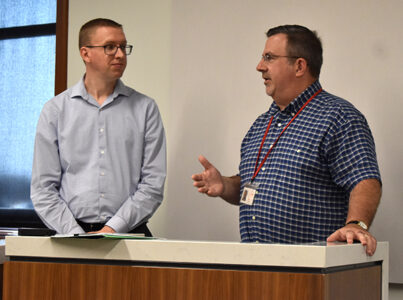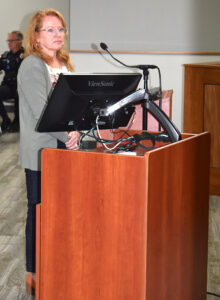Marshalltown Legionnaires’ outbreak has high infection rate
The Marshalltown Legionnaires’ disease outbreak has an “explosive” rate of infection.
Former New York City Health Assistant Commissioner for Environmental Sciences & Engineering Chris Boyd became aware of the outbreak last week. He estimated that the Marshalltown infection rate is 75 out of 100,000, higher than the July outbreak in Harlem, in which 58 people were diagnosed in the span of 10 days and two people died.
“[It] is at the very high end of what I’ve seen — higher even than NYC’s Harlem outbreak in 2025, the city’s second largest,” he said.
What captured his attention was the T-R story about Father Bernard Grady, which was shared on LinkedIn, and one of Boyd’s colleagues flagged it. Boyd described the story as heartbreaking.
“His suffering and the impossible choices his family faced underscore that Legionnaires’ is not an abstract statistic, but a preventable man-made tragedy,” he said.
What alarmed Boyd further was the reluctance of public health officials to release information because they did not want to cause panic.
“In my experience, secrecy doesn’t prevent panic. It creates distrust and rumors,” he said. “Transparency builds trust, saves lives and gives physicians and the public the tools they need to act quickly.”

Warme
Iowa Sen. Kara Warme (R-Ames) serves on the Health and Human Services Committee and said the Iowa Department of Health and Human Services (HHS) has a system in place which has worked.
“The idea is to balance the need for Iowans to know and be as safe as possible with valid information and not causing unneeded panic,” she said.
Warme has been following the situation since she found out about the Legionnaires’ outbreak in her district.
“It is not something we hear a lot about,” she said. “Public health said it is not uncommon, but I can’t recall hearing about it in our district. So, I am following this closely and getting updated from [HHS and legislative] staff.”
At a Wednesday Marshall County Board of Supervisors meeting, State Epidemiologist Dr. Matthew Donahue said people in Marshalltown could go out and about. Previously, HHS stated the risk to the public was “low.” According to Boyd, that framing is misleading. While most healthy people exposed to the bacteria don’t get sick, higher-risk individuals — those over 50, smokers, people with chronic lung disease or weakened immune systems — are more vulnerable.
“In Marshalltown, over one-third of residents fall into those higher-risk categories,” he said. “Clear communication that distinguishes between low risk for the general population and high risk for vulnerable groups is critical. Anything less creates false reassurance and endangers lives.”
On Thursday, HHS confirmed 38 cases of Legionnaires,’ an increase of four from Wednesday. Warme said, fortunately, health officials have been identifying the possible sources of the outbreak, 10 cooling towers, and testing is underway.
“I hope new cases will drop off before we can get confirmation of where it came from,” she said.
Cooling towers
Boyd, a senior consultant with MARC Strategic Solutions — a firm that advises public and private sectors on public health policy, security and sustainability — has a history of working on Legionnaires’ outbreaks. He organized three national conferences on the disease and advised Los Angeles County, New Brunswick and Vancouver on adopting regulations to prevent exposure to legionella, the bacteria which causes Legionnaires.’ A major focus of his work is legionella risk management.
During his time with the NYC Health Department, Boyd managed the environmental health response to 15 Legionnaires’ outbreaks, including the largest in 2015 with 138 cases. The latter outbreak drove the city to adopt the nation’s first proactive cooling tower regulations and registry, which have since reduced Legionnaires’ disease in New York City even as cases rise nationwide, he added.
“NYC pioneered environmental investigation strategies that became national models, including the early use of molecular testing to rapidly identify sources and protect the public,” he said. “That approach is still the gold standard today.”
The process of testing someone for Legionnaires’ disease is not difficult and the results can help with identifying outbreak sources, Boyd said. Normally, it’s a simple urine antigen test which identifies the majority of cases. However, he added it can only detect one strain, but it is the most dangerous one. Ideally, physicians should also collect a sputum sample which allows investigators to genetically match patient samples to environmental sources.
“[That’s] critical for pinpointing the exact cooling tower or system causing the outbreak,” Boyd said.
While HHS and Marshall County Public Health have not disclosed the location of the 10 cooling towers that are being tested, the state did indicate that the people with Legionnaires’ are all residents of north central Marshalltown. Public health officials have directed the disinfection of the towers as soon as possible, regardless of the test results.
Boyd said that is what a healthy agency should be doing, and people should not wait for possible total amounts of the bacteria to be quantified in a final lab report.
He added that the legionella bacteria in the natural environment is not a public concern. However, when legionella meets poorly maintained engineered water systems, it multiplies and spreads through water droplets in the air.
“This is not a natural disease. It is preventable,” he said. “Leading agencies worldwide, from CDC to the UK Health and Safety Executive, agree — strong, enforced water management programs stop outbreaks before they start.”
——–
Contact Lana Bradstream at 641-753-6611 ext. 210 or lbradstream@timesrepublican.com.





